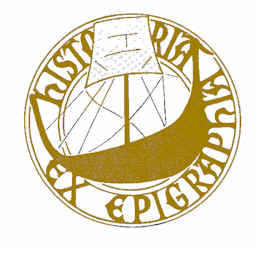
The Epigraphic Society

|
The Epigraphic Society
|
|
|
Epigraphic
Society Occasional Publications Table of Contents Vol. 12/2, 1984Australian and Spanish Stamps Depicting Petroglyphs (3 pp) Brian Cashman & Warren Dexter 12/2-pp 119,208, 209, 219, 222 Sheep Eaters (Desert Bighorn Petroglyphs) (1 p) John Lehman 12/2-p 120 Lehman sent Fell the print of a slide taken of a petroglyph at a site on the Dolores River near Whiskey Mountain, Ring Lake and the Town of Dubois, Wyoming. Desert Bighorn Wool and Some Aspects of Behavior (1 p) Michael P. Coffeen 12/2-p 121 A wildlife biologist comments on the many petroglyphs of bighorn sheep. Ogam in Nevada (1 p) Bill Chivvis & Barry Fell 12/2-p 122 Chivvis sent Fell a photo of petroglyphs showing apparent Ogam. One is seen by Fell as the Celtic word UI-S-G = uisge = "water." Balance Rock (1 p) Kenneth E. Price 12/2-p123 Possible megaliths in Lawrence Co., Pennsylvania, near the junction of Slippery Rock Creek and Connoquenessing Creek. Petroglyphs from the Superstition Wilderness Area, Tonto National Forest, Arizona (4 pp) C. Earl Phillips & Barry Fell 12/2-p 124 The writer illustrates his ideas about the meanings assigned to some of the petro- glyphs. In a postscript, Fell deciphers some of the petroglyphs reported by Mr. Phillips. Herbs, Plants and Tribalism (4 pp) Robert B. McFarland 12/2-p 128 The author speaks about Amerindian medicine, tribalism, and his preference for small governmental units. The Kinderhook Plates (10 pp) Barry Fell 12/2-p 132 Fell proves that the plates found in Pike County Illinois are fakes made in 1843. The Centuripe Vase (7 pp) Donal Buchanan 12/2-p142 Decipherment of an inscribed vase found at Centuripe, Sicily, in 1824. Buchanan identifies the script as Iberic and identifies the language as a dialectical form of Vulgar Latin. He believes it to be a memorial to a Roman fallen in Iberia returned to his family as a token of esteem and memory. Ancient Writing from Spiro Mounds (9 pp) Gloria Farley 12/2-p149 A Tanith-figure from Spiro bears an inscription deciphered by Dr. Fell. He identified the script as Numidian and the language as Libyan. Mythology and Epigraphy (24 pp) Douglas G. Blizzard 12/2-p 158 Comments on giants, dwarves, goblins and humanoid and animal monsters depicted graphically in various sites. The Huntington Ring (3 pp) L. Lyle Underwood 12/2-p182 A very old and worn seal ring found at Huntingdon, Virginia (seeESOP8/2 p.218) is an early form ofa Mason's square. A Possible Calendar Inscription (5 pp) Paul H. Chapman 12/2-p 185 A pictograph found in a prehistoric California cave may have been used to calibrate a calendar. Egyptian Signs in the Hawaiian Islands (12 pp) Ruth Knudsen 12/2-p 190 Three sites in Hawaii have petroglyphs which appear to be hiero- glyphic. An Inscribed Gold Plate from Peru (4 pp) Paul R. Cheesman 12/2-p 202 A gold plate from Lamboyeque, Northern Peru, is submitted to Fell. Decipherment of the Lamboyeque Gold Plate (2 pp) Barry Fell 12/2-p 206Fell relates the script to Common Cypriot and states that the plate is a "manipulative puzzle." More Moonwatching: The Moon by Day (10 pp) Charles C. Fulton 12/2-p 210 Discourse on the meanings of representations of the crescent moon. Some Comments on the Origin of the Pima-Papago language (3 pp) Phillip M. Leonard 12/2-p 220 Compares the language to Semitic. North African Astronomical Petroglyphs in Utah (3 pp) Phillip M. Leonard & James L. Glenn 12/2-p 223 Petroglyphs from Dry Forks Canyon, north of Vernal, Utah, are deciphered. On the CoverPre-Columbian Crab God, Northern Peru, Moche River area. See page 171 of Douglas Blizzard's article on Mythology and Epigraphy, in this issue. _______________________________________________________________ |
Send mail to donalbb@epigraphy.org
with
questions or comments about this web site.
|